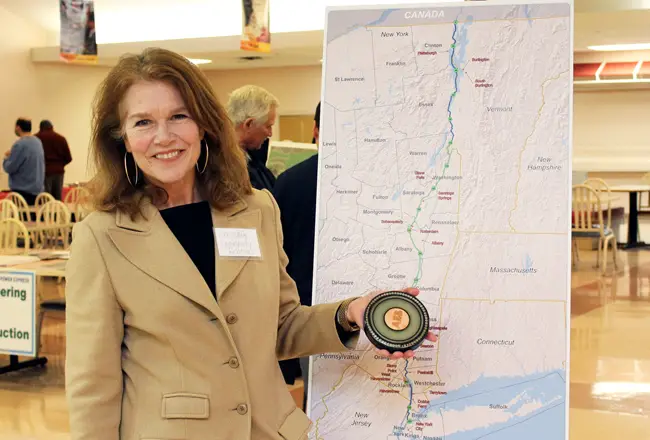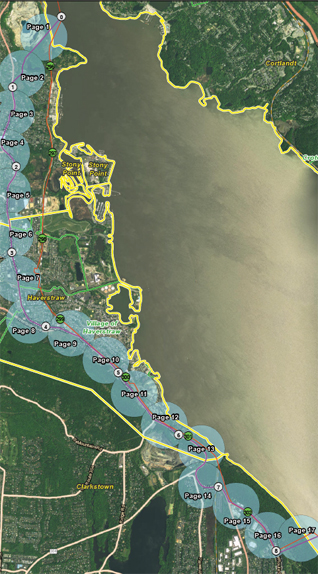Transmission Developers Inc. has new route, outreach for hydropower line
Standing in front of a poster tracing the route of a proposed 333-mile long transmission line that would stretch from Canada to Queens, a representative of Transmission Developers Inc. assured two Rockland County residents that the line would not affect their property.
In the other corner of the Rockland ARC cafeteria in Congers, a TDI engineer explained the process by which the transmission line”™s high voltage cables would be placed along waterways or, as is the case for much of Rockland, buried underground.

Transmission Developers Inc. was in town for the first of a series of community outreach events that cover changes to the route of its $2.2 billion cross-border transmission line called the Champlain Hudson Power Express. The line would connect New York with about 1,000 megawatts of excess hydropower from the Canadian utility Hydro Quebec.
For TDI, the meetings represent just the latest step in a process that extends back a decade, when the plans for the line were first formulated. TDI is an affiliated company of Blackstone Group LP, one of the country”™s largest private equity firms.
The project has already received approvals from the New York Public Service Commission and a federal presidential permit required for cross-border transmission. But construction has been held up while certain parts of the line are reworked. Any changes have to be approved by state and federal agencies.
In Rockland County, TDI spokeswoman Jennifer Laird-White, a former mayor of Nyack, said the company decided to reroute to meet community concerns.
The majority of the Champlain Hudson line”™s two, 5-inch diameter cables will run underwater along Lake Champlain, the Hudson River and the East and Harlem rivers until reaching a substation in Queens. But the underwater route does divert onto land along the way. Those portions of the line, about 137 miles total, will be buried beneath existing rights of way.
One of the underground sections is in Rockland. In 2013, Transmission Developers Inc. agreed to route the transmission line over land starting in north Rockland to avoid Haverstraw Bay, a sensitive river habitat.
Under the first reroute, negotiated with environmental groups Riverkeeper and Scenic Hudson, the line emerged from the Hudson near Stony Point Park and then re-entered the river near Rockland Lake.
 The agreement between TDI and the two environmental groups also had the company agree to provide $117 million over 35 years for habitat restoration and other enhancement projects in the Hudson, East and Harlem rivers and Lake Champlain.
The agreement between TDI and the two environmental groups also had the company agree to provide $117 million over 35 years for habitat restoration and other enhancement projects in the Hudson, East and Harlem rivers and Lake Champlain.
While the line may avoid sensitive areas of the Hudson, it went through a few areas that caught the attention of Rockland residents. A major source of community concern came from the line”™s proximity to Waldron Cemetery, a historic graveyard for Revolutionary War soldiers.
The transmission line”™s new path swings a little farther inland, following Route 9W for about 7 miles between the towns of Stony Point and Clarkstown before entering the river again near Rockland Lake.
The informational meeting on March 5 focused mostly on explaining the new route. Laird-White said the company wants to “inform the community as fully as possible about the particulars of the proposed new route” before applying to the Public Service Commission for modifications to its permit.
The route change comes with financial benefits for the municipalities involved. In January, the towns of Stony Point, Haverstraw and Clarkstown, along with the villages of West Haverstraw and Haverstraw, signed a memorandum of understanding with the company.
The agreement has each municipality sign off on the new route and provides the municipalities with $31 million from TDI for capital improvements. Of that money, $22 million will go to new capital projects and $9 million to road improvements along the Route 9W corridor.
Stony Point Town Supervisor James Monaghan said in a statement following approval of the memorandum that the project “will give us substantial much-needed long-term tax revenue.”
That revenue, as estimated by the company, is $150 million through Rockland County over the project”™s first 30 years. TDI also projects the transmission line will create 800 long-term jobs over that same time frame and 2,600 construction jobs. TDI estimates the hydropower it brings south will save New York ratepayers $355 million per year.
The line could serve as part of the solution for replacing the power lost by the closing of the Indian Point Energy Center. When the Buchanan nuclear plant shuts down, most likely by 2021, it will result in the loss of 2,000 megawatts, about a quarter of the electricity for New York City and Westchester County.
At 1,000 megawatts, the Champlain Hudson Express could make up for about half that gap. Gov. Andrew M. Cuomo seemed to refer to the project, though not by name, as a replacement to Indian Point when he announced the legal settlement that assured the plant”™s closing in 2017.
In a press release from his office announcing Indian Point”™s closing, it stated that “several generation resources are also fully permitted and readily available to come online by 2021 … including clean, reliable hydropower able to replace up to 1,000 megawatts of power.” TDI displays that quote prominently in a promotional fact sheet about the project.
At a New York Legislature special hearing in February 2017 on Indian Point”™s closing, former Public Service Commission Chair Audrey Zibelman was less direct. She said the line was only “supplemental to the activities we”™re already doing” to help replace Indian Point”™s power. She said the state”™s focus is on boosting renewables, energy efficiency and improving transmission capabilities.
A report backed by Riverkeeper and the Natural Resources Defense Council published in 2017 said Indian Point”™s power could be replaced by a combination of the Champlain Hudson line and boosting renewables and energy efficiency.
The Champlain Hudson line lists supporters in environmental groups such as Riverkeeper, Scenic Hudson and the New York League of Conservation Voters. But not all environmental groups favor the idea of major hydro imports, arguing the imported energy could undermine local renewable generation efforts. The Sierra Club and Alliance for Clean Energy New York have publicly expressed such concerns.
TDI”™s idea for importing power from Canada also has won it few friends among New York power producers. The industry group Independent Power Producers of New York opposed its approval during the state Public Service Commission review process. As did the New York Affordable Reliable Electricity Alliance, an energy advocacy group that includes consumers, producers and distributors of electricity.
After the project received state approval in 2013, New York AREA chairman Arthur J. Kremer said that it would “send billions of dollars to Canada for a product that we can make less expensively and more reliably in New York.”
Transmission Developers Inc. says the line is a merchant product, meaning the company must fund its construction and find its own customers for the electricity without help from ratepayers.
The company hopes to start construction in 2019 and have the line transmitting energy by 2022.